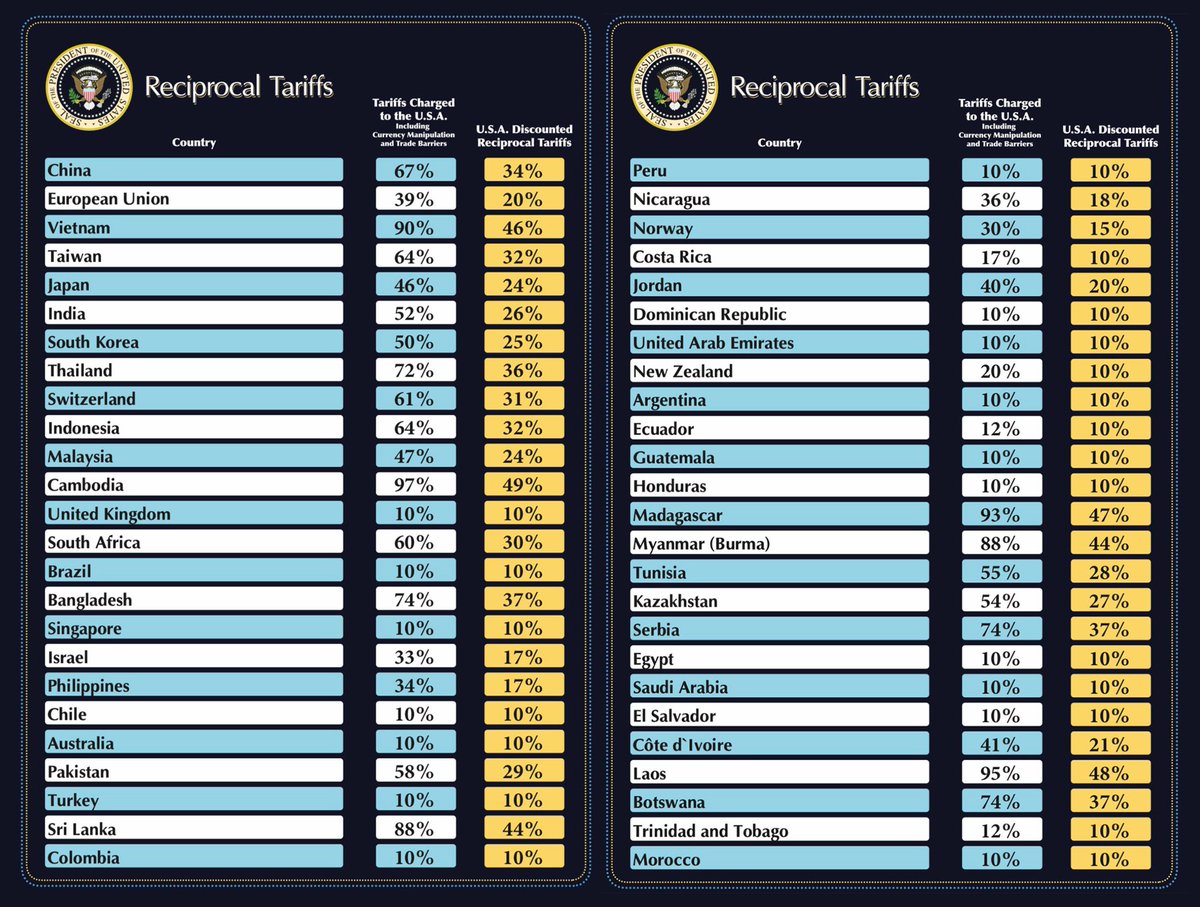Welcome to DU!
The truly grassroots left-of-center political community where regular people, not algorithms, drive the discussions and set the standards.
Join the community:
Create a free account
Support DU (and get rid of ads!):
Become a Star Member
Latest Breaking News
Editorials & Other Articles
General Discussion
The DU Lounge
All Forums
Issue Forums
Culture Forums
Alliance Forums
Region Forums
Support Forums
Help & Search
General Discussion
Related: Editorials & Other Articles, Issue Forums, Alliance Forums, Region ForumsWashington Post-Economists say the way Trump calculated tariffs makes no sense
The formula used by trump makes no sense
An overly simplistic formula for “reciprocal tariffs” is unlikely to lead to the elimination of trade deficits, trade experts warn.
https://bsky.app/profile/dailybug.bsky.social/post/3llwqvnpvb22c
Link to tweet
https://www.washingtonpost.com/business/2025/04/03/how-trump-calculated-tariffs
Economists say the crude formula the White House used to calculate what it’s calling “reciprocal tariffs” is too simplistic to achieve its goal of wiping out U.S. trade deficits — and, for that matter, they say that goal doesn’t make sense, either.....
The math used to come up with those rates is what experts are lampooning.
A formula released by the U.S. trade representative ties those punitive taxes to the United States’ bilateral trade deficit in goods with each country — in other words, how much more the U.S. imports from those countries than it exports to them. The calculation finds the ratio between the U.S. trade deficit with a country and that country’s total exports to the U.S. It then divides the ratio in half to produce what the administration called a “discounted reciprocal tariff.”
Economists criticized the formula for its assumption that persistent trade deficits are a reflection of allegedly unfair trade practices by U.S. trading partners. They point out that the math apparently leaves out services — which make up the bulk of the U.S. economy and an important proportion of its exports — from calculations of trade deficits, which has the effect of making U.S. trade relationships look more one-sided.
They also say there’s nothing “reciprocal” about the punitive tax rates because they’re disconnected from any actual barriers countries impose on U.S. imports.
“They’ve got an indefensible foundation to an indefensible policy,” said Douglas Holtz-Eakin, president of the conservative American Action Forum.......
The formula produces significantly different results based entirely on the size of a country’s trade deficit or surplus with the United States, heavily penalizing any nations that have sold more goods here than they have bought. For instance, Vietnam and Cambodia face massive additional tariffs of 46 percent and 49 percent, respectively, because of their large trade deficits with the United States — deficits that sprang up recently in part because companies moved production to those countries when the U.S. government indicated it didn’t want them making goods in China. The European Union, with a more modest trade deficit, faces a 20 percent added tax.

Meanwhile, countries that don’t have a trade deficit with the U.S. will pay only the flat 10 percent tax imposed on all goods. Countries the White House put in that club include Britain, Brazil and Singapore.
The math used to come up with those rates is what experts are lampooning.
A formula released by the U.S. trade representative ties those punitive taxes to the United States’ bilateral trade deficit in goods with each country — in other words, how much more the U.S. imports from those countries than it exports to them. The calculation finds the ratio between the U.S. trade deficit with a country and that country’s total exports to the U.S. It then divides the ratio in half to produce what the administration called a “discounted reciprocal tariff.”
Economists criticized the formula for its assumption that persistent trade deficits are a reflection of allegedly unfair trade practices by U.S. trading partners. They point out that the math apparently leaves out services — which make up the bulk of the U.S. economy and an important proportion of its exports — from calculations of trade deficits, which has the effect of making U.S. trade relationships look more one-sided.
They also say there’s nothing “reciprocal” about the punitive tax rates because they’re disconnected from any actual barriers countries impose on U.S. imports.
“They’ve got an indefensible foundation to an indefensible policy,” said Douglas Holtz-Eakin, president of the conservative American Action Forum.......
The formula produces significantly different results based entirely on the size of a country’s trade deficit or surplus with the United States, heavily penalizing any nations that have sold more goods here than they have bought. For instance, Vietnam and Cambodia face massive additional tariffs of 46 percent and 49 percent, respectively, because of their large trade deficits with the United States — deficits that sprang up recently in part because companies moved production to those countries when the U.S. government indicated it didn’t want them making goods in China. The European Union, with a more modest trade deficit, faces a 20 percent added tax.
Link to tweet

Meanwhile, countries that don’t have a trade deficit with the U.S. will pay only the flat 10 percent tax imposed on all goods. Countries the White House put in that club include Britain, Brazil and Singapore.
1 replies
 = new reply since forum marked as read
Highlight:
NoneDon't highlight anything
5 newestHighlight 5 most recent replies
= new reply since forum marked as read
Highlight:
NoneDon't highlight anything
5 newestHighlight 5 most recent replies
Washington Post-Economists say the way Trump calculated tariffs makes no sense (Original Post)
LetMyPeopleVote
Yesterday
OP
LetMyPeopleVote
(160,942 posts)1. The formula for these tariffs is stupid